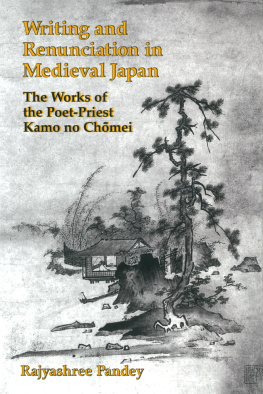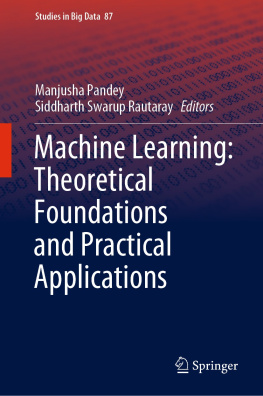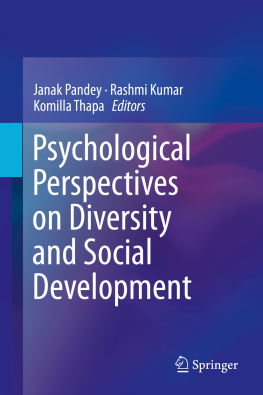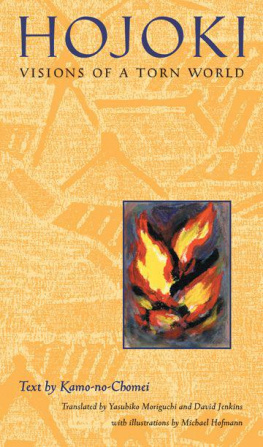Rajyashree Pandey - Writing and Renunciation in Medieval Japan: The Works of the Poet-Priest Kamo no Chōmei
Here you can read online Rajyashree Pandey - Writing and Renunciation in Medieval Japan: The Works of the Poet-Priest Kamo no Chōmei full text of the book (entire story) in english for free. Download pdf and epub, get meaning, cover and reviews about this ebook. year: 2020, publisher: University of Michigan Center for Japanese Studies, genre: Religion. Description of the work, (preface) as well as reviews are available. Best literature library LitArk.com created for fans of good reading and offers a wide selection of genres:
Romance novel
Science fiction
Adventure
Detective
Science
History
Home and family
Prose
Art
Politics
Computer
Non-fiction
Religion
Business
Children
Humor
Choose a favorite category and find really read worthwhile books. Enjoy immersion in the world of imagination, feel the emotions of the characters or learn something new for yourself, make an fascinating discovery.
- Book:Writing and Renunciation in Medieval Japan: The Works of the Poet-Priest Kamo no Chōmei
- Author:
- Publisher:University of Michigan Center for Japanese Studies
- Genre:
- Year:2020
- Rating:4 / 5
- Favourites:Add to favourites
- Your mark:
- 80
- 1
- 2
- 3
- 4
- 5
Writing and Renunciation in Medieval Japan: The Works of the Poet-Priest Kamo no Chōmei: summary, description and annotation
We offer to read an annotation, description, summary or preface (depends on what the author of the book "Writing and Renunciation in Medieval Japan: The Works of the Poet-Priest Kamo no Chōmei" wrote himself). If you haven't found the necessary information about the book — write in the comments, we will try to find it.
Rajyashree Pandey: author's other books
Who wrote Writing and Renunciation in Medieval Japan: The Works of the Poet-Priest Kamo no Chōmei? Find out the surname, the name of the author of the book and a list of all author's works by series.
Writing and Renunciation in Medieval Japan: The Works of the Poet-Priest Kamo no Chōmei — read online for free the complete book (whole text) full work
Below is the text of the book, divided by pages. System saving the place of the last page read, allows you to conveniently read the book "Writing and Renunciation in Medieval Japan: The Works of the Poet-Priest Kamo no Chōmei" online for free, without having to search again every time where you left off. Put a bookmark, and you can go to the page where you finished reading at any time.
Font size:
Interval:
Bookmark:

Writing and Renunciation in Medieval Japan
Michigan Monograph Series in Japanese Studies
Number 21
Center for Japanese Studies
The University of Michigan
Writing and Renunciation in Medieval Japan
The Works of the Poet-Priest Kamo no Chmei
Rajyashree Pandey
Center for Japanese Studies
The University of Michigan
Ann Arbor, 1998
1998 The Regents of the University of Michigan
All rights reserved
Published by the Center for Japanese Studies, The University of Michigan, 202 S. Thayer St., Ann Arbor, MI 481041608
Distributed by The University of Michigan Press, 839 Greene St. / P.O. Box 1104, Ann Arbor, MI 481061104
Library of Congress Cataloging in Publication Data
Pandey, Rajyashree, 1953
Writing and renunciation in medieval Japan : the works of the poet-priest Kamo no Chmei / Rajyashree Pandey.
199 p. 23 cm.(Michigan monograph series in Japanese studies : 21)
Includes bibliographical references and index.
ISBN 0939512866 (alk. paper)
1. Kamo, Chmei, 1153?1216?Criticism and interpretation.
I. Title. II. Series.
PL791.2.Z5P36 1998
895.6422dc21
9812208
CIP
Jacket illustration: Bunsei, Landscape (detail), Japanese, mid-15th century, Muromachi period. Hanging scroll, ink and light colors on paper (05.203). Chinese and Japanese Special Fund. Courtesy of the Museum of Fine Arts, Boston.
Jacket design: Seiko Semones
This publication meets the ANSI/NISO Standards for Permanence of Paper for Publications and Documents in Libraries and Archives (Z39.481992).
Published in the United States of America
ISBN 978-0-939512-86-7 (hardcover)
ISBN 978-0-472-03828-2 (paper)
ISBN 978-0-472-12793-1 (ebook)
ISBN 978-0-472-90189-0 (open access)
To the memory of Ai
Contents
My first encounter with classical Japanese literature came through a chance reading of Arthur Waleys translation of Genji monogatari. A student of English and French literature in India, I had hitherto had little contact with other Asian culturesmy formal education bore all the marks of its colonial origins. Waleys Genji offered me a first and beguiling glimpse of a world that shared something of the Indian religious sensibility but expressed itself in an aesthetic mode quite alien to that found in Indian literary writing. It was with a desire to pursue this newfound Japan, from the perspective of an Indian steeped in the Western tradition, that I embarked upon my study of Japanese language and literature. Friedhelm Hardy offered enthusiastic support in the early days of this new venture.
My interest in classical Japanese literature was sustained and encouraged by a number of fine teachers. Dr. James McMullen at Oxford University inspired me with his academic rigor and his knowledge of classical Japanese literature. Subsequently, Professors Robert Morrell and Thomas Rimer, then at Washington University in St. Louis, guided me through a study of a variety of classical Japanese texts. Working with them paved the way for my engagement with popular medieval narratives, particularly those inflected with strong Buddhist overtones.
The idea for this book first germinated when I completed my doctoral dissertation on the works of Kamo no Chmei at the Australian National University in 1989. My decision to focus on Kamo no Chmei was guided by the fact that, although he was a major literary and intellectual figure of the medieval period, he had received surprisingly little systematic attention outside of Japan. I wish to express my deepest gratitude to my dissertation advisor and friend, Dr. Tom Harper, who simultaneously advised, listened, and offered help, while at the same time encouraged me to find my own path. He pointed me to a wide range of medieval literary texts that had been little explored outside of Japan.
In the course of this research, I was struck by the persistence with which the question of the value and legitimacy of writing was debated in medieval Japanese writing, and by the way in which the question of writing came to be formulated and addressed from within a Buddhist epistemic framework. I found that Kamo no Chmeis works acquired greater significance and richness once they were read in conjunction with other medieval texts, many of which were bound by a common thread: the imperative to work out the relationship between writing, a profoundly worldly activity, and renunciation, which was central to the attainment of Buddhist enlightenment.
During a number of research trips to Japan, I had the good fortune to work with Professor Yamada Shozen at Taisho University and Professors Mizuhara Hajime and Yasuaki Nara at Komazawa University. I cannot thank them enough for the generosity with which they gave of their time and their knowledge. Dr. Michael Cooper provided much encouragement and support during my stays in Tokyo. I also owe a deep debt of gratitude to Mrs. Sonoe Matsui and her family, who adopted me into their home and looked after me as one of their own.
There are many friends who have contributed to the making of this book: my thanks to Dipesh Chakrabarty, Frieda Freiberg, Leela Gandhi, Aruna Hardy, Iso Mizue, Pauline Nestor, Bee Chin Ng, and Vanita Seth. I would also like to thank Professor Andrew Gerstle for his many useful comments. I am grateful to Dr. Sandra Wilson for her meticulous reading of the manuscript and her many suggestions. My thanks also to an extremely rigorous anonymous referee, whose many suggestions and criticisms I have tried to incorporate. Needless to say, all shortcomings of the work are my responsibility.
I cannot thank Sanjay Seth enough for his companionship and his unstinting generosity in reading successive drafts of the book and refusing to be easily persuaded by its arguments. The good humor and cheerfulness of my son Nishad did much to alleviate the depression of bad writing days.
Finally, I would like to thank the following institutions for their support: the Japan Foundation for a dissertation fellowship, the Australian National University for a dissertation scholarship, and La Trobe University for a semesters sabbatical leave to complete the draws upon material previously published in the Journal of the Royal Asiatic Society under the title, Love, Poetry and Renunciation: Changing Configurations of the Ideal of Suki. I am grateful to the Journal of the Royal Asiatic Society for permission to use this material.
In Japan there was no written literary tradition predating the advent of Buddhism, and the introduction of a written script from China went hand in hand with the encounter with Buddhist canonical writing. The earliest attempts to grapple with the written word took the form of reading Buddhist sutras written in Chinese. Thus, from the beginning, the aesthetic tradition that emerged was already being shaped by Buddhist ideals and practices.
The emergence of this religio-aesthetic tradition, in which aesthetics could not be defined outside of Buddhism, did not take place, however, in an unproblematic and unselfconscious manner. A potential conflict manifested itself when Japanese writers sought to consider what the implications of the act of writing, seen as a fundamentally worldly pursuit, were for the goals of detachment and renunciation central to the experience of Buddhist enlightenment.
Doubts about the value of worldly writings, as well as the possibility of the resolution of these doubts, had already been debated by litterateurs in China. Their writings played no small part in the Japanese understanding of the possibilities and limitations of literary endeavor within a predominantly Buddhist context. Thus the history of literary writing in medieval Japan is punctuated by a series of explorations of this tension between writing, which was seen as a form of attachment, and the goal of renunciation. The engagement with this problem, and the conscious attempt to overcome it, generated an aesthetic that could not be understood outside the realm of the religious. However, the reconciliation was never a given and was achieved only through considerable debate regarding the relationship between the two and through theorizing about both their separation and their indivisibility.
Font size:
Interval:
Bookmark:
Similar books «Writing and Renunciation in Medieval Japan: The Works of the Poet-Priest Kamo no Chōmei»
Look at similar books to Writing and Renunciation in Medieval Japan: The Works of the Poet-Priest Kamo no Chōmei. We have selected literature similar in name and meaning in the hope of providing readers with more options to find new, interesting, not yet read works.
Discussion, reviews of the book Writing and Renunciation in Medieval Japan: The Works of the Poet-Priest Kamo no Chōmei and just readers' own opinions. Leave your comments, write what you think about the work, its meaning or the main characters. Specify what exactly you liked and what you didn't like, and why you think so.













